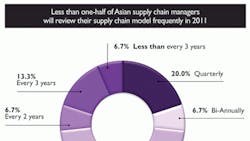We hear a lot about nearshoring in the United States, the practice of moving production and sourcing closer to the point of consumption (which generally means relocating factories from China to Mexico or Latin America, not necessarily returning to the U.S.). As it turns out, supply chain managers in the Asia-Pacific region are also adopting a "close to home" logistics strategy, particularly when it comes to warehousing activities.
According to a recent study of Asian supply chain managers conducted by business analysis firm Analytiqa, unanticipated transportation disruptions as a result of natural disasters in the Asia-Pacific region have highlighted how multinational manufacturers can find themselves without critical components and finished inventory. (The study was conducted before the Japanese earthquake and tsunami, but natural disasters have been frequent in the region, including the 2004 Indonesian tsunami and the 2008 earthquake in western China).
Asian manufacturers know first-hand the implications of damaged transportation infrastructure, and when you factor in the volatility in fuel prices, it becomes obvious why many of these companies have opted to outsource key components of their supply chain management to third-party logistics providers (3PLs). As Analytiqa reports, these manufacturers are looking for 3PLs with proven track records for service and expertise within their operating markets.
Similarly, the strategies of Asia-Pacific supply chain managers are focused on many of the same issues their U.S. counterparts are dealing with, such as forecasting accuracy, intensifying supply chain complexity, managing the strain of increasing costs and aligning the performance of 3PLs to their strategic supply chain goals.
Recognizing the need to improve logistics efficiency, Asia-Pacific manufacturers plan to launch strategic initiatives over the next two years to help benchmark their supply chain performance, investigate alternative transport modes and increase their supply chain forecasting accuracy. Even so, only 47% of these companies plan to frequently review their supply chain model this year.
See Also:
• Cargill Flies a Kite to Reduce Fuel Consumption
• Portrait of Supply Chain Visibility
• Top 11 Priorities for Supply Chain Information Technology
About the Author
Dave Blanchard
Senior Director of Content
Focus: Supply Chain
Call: (941) 208-4370
Follow on Twitter @SupplyChainDave
During his career Dave Blanchard has led the editorial management of many of Endeavor Business Media's best-known brands, including IndustryWeek, EHS Today, Material Handling & Logistics, Logistics Today, Supply Chain Technology News, and Business Finance. He also serves as senior content director of the annual Safety Leadership Conference. With over 30 years of B2B media experience, Dave literally wrote the book on supply chain management, Supply Chain Management Best Practices (John Wiley & Sons, 2010), which has been translated into several languages and is currently in its second edition. He is a frequent speaker and moderator at major trade shows and conferences, and has won numerous awards for writing and editing. He is a voting member of the jury of the Logistics Hall of Fame, and is a graduate of Northern Illinois University.
